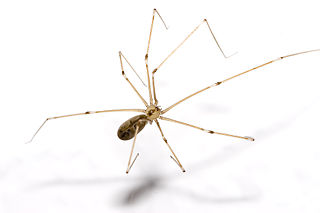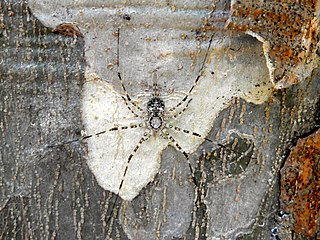
Huntsman spiders, members of the family Sparassidae, catch their prey by hunting rather than in webs. They are also called giant crab spiders because of their size and appearance. Larger species sometimes are referred to as wood spiders, because of their preference for woody places. In southern Africa the genus Palystes are known as rain spiders or lizard-eating spiders. Commonly, they are confused with baboon spiders from the Mygalomorphae infraorder, which are not closely related.

The Pholcidae are a family of araneomorph spiders. The family contains more than 1,800 individual species of pholcids, including those commonly known as cellar spider, daddy long-legs spider, carpenter spider, daddy long-legger, vibrating spider, gyrating spider, long daddy, skull spider, and angel spider. The family, first described by Carl Ludwig Koch in 1850, is divided into 94 genera.

Velvet spiders are a small group of spiders almost entirely limited to the Old World, with the exception of one species known from Brazil. In Europe, some are commonly called the ladybird spiders.

Strombidae, commonly known as the true conchs, is a taxonomic family of medium-sized to very large sea snails in the superfamily Stromboidea, and the Epifamily Neostromboidae. The term true conchs, being a common name, does not have an exact meaning. It may generally refer to any of the Strombidae but sometimes is used more specifically to include only Strombus and Lambis. The family currently includes 26 extant, and 10 extinct genera.

The Crocodile Lake National Wildlife Refuge is part of the United States National Wildlife Refuge System, located in north Key Largo, less than 40 miles (64 km) south of Miami off SR 905. The 6,686 acres (2,706 ha) refuge opened during the year of 1980, under the Land and Water Conservation Fund Act of 1965 and the Endangered Species Act of 1973. It was established in order to protect critical breeding and nesting habitat for the threatened American crocodile and other wildlife. This area also includes 650 acres (260 ha) of open water in and around the refuge. In addition to being one of only three breeding populations of the American crocodile, the refuge is home to tropical hardwood hammock, mangrove forest, and salt marsh. It is administered as part of the National Key Deer Refuge which is also located in the Florida Keys.

Xylotoles costatus, the Pitt Island longhorn beetle, is a species of beetle in the family Cerambycidae. It is endemic to the Chatham Islands. Once thought to be extinct, it is now known to survive on South East Island/Rangatira; being therefore an example of a so-called "Lazarus taxon".

Macrostrombus costatus, formerly known as Strombus costatus and Lobatus costatus, or commonly known as the milk conch, is a species of large sea snail, a marine gastropod mollusk in the family Strombidae, the true conchs. They are an edible species and important food source for the inhabitants of where they are found. Conchs are most notable for their medium to large-sized ornamental shells. Milk conchs are dispersed among the tropical waters of the Atlantic Ocean, along the coasts and islands of North, Central, and South America.

Elaeocarpus costatus is a species of flowering plant in the family Elaeocarpaceae that is endemic to Lord Howe Island. It is a tree with lance-shaped to elliptic leaves with wavy-toothed edges, flowers in groups of eight to ten, and blue fruit.

Poecilopompilus is a fossorial genus of the family Pomplidae found in the New World. The main prey of these wasps are spiders of the family Araneidae.

Alireza Zamani is an Iranian arachnologist and taxonomist.

Pityohyphantes, commonly known as hammock spiders, is a genus of sheet weavers that was first described by Eugène Louis Simon in 1929. The name comes from the Ancient Greek Πίτυς (pitys), meaning "pine", and hyphantes, meaning "weaver".
Buchananius is a genus of flower weevils in the beetle family Curculionidae. There are nine described species in Buchananius.
Pityohyphantes tacoma is a species of sheetweb spider in the family Linyphiidae. It is found in the United States.
Dicaelus costatus, the South Texas embossed carabid, is a species of ground beetle in the family Carabidae. It is found in North America.
Pityohyphantes subarcticus is a species of sheetweb spider in the family Linyphiidae. It is found in Canada and USA (Alaska).
Alniphagus is a genus of crenulate bark beetles in the family Curculionidae. There are about eight described species in Alniphagus.

Neotama mexicana, also known as the long-spinneret spider or Mexican two-tailed spider, is a species of tree trunk spider in the family Hersiliidae. It is found in a range from the United States to Peru and Guyana.
Pterostichus costatus is a species of woodland ground beetle in the family Carabidae. It is found in Europe and Northern Asia and North America.
Pityohyphantes cristatus is a species of sheetweb spider in the family Linyphiidae. It is found in the United States.
Sosylus costatus is a species of dry bark beetle in the family Bothrideridae. It is found in North America.











